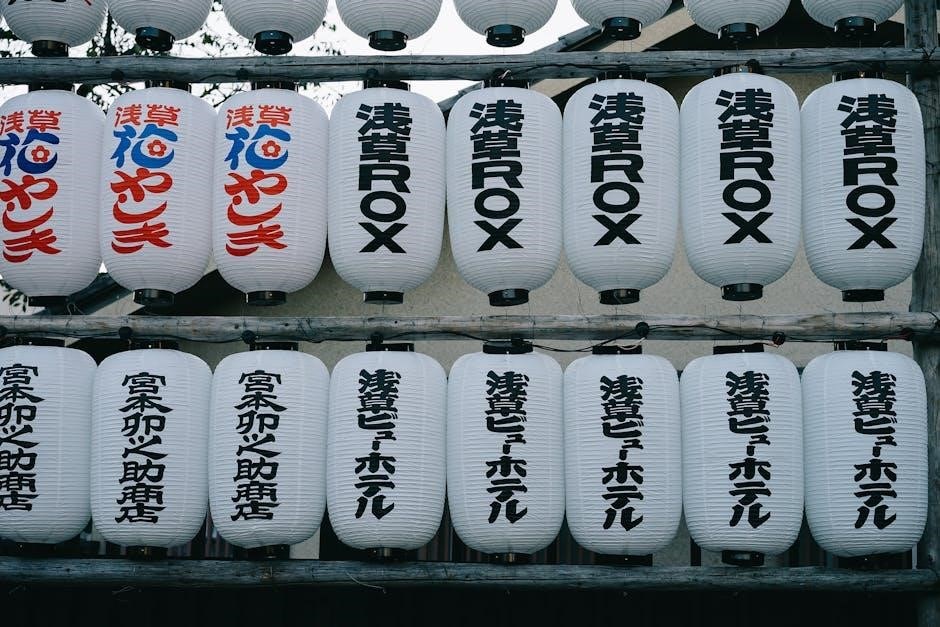The introduction to 2000 most common Japanese kanji pdf provides essential information on Japanese characters, including their meanings and usage, with online resources available for learning and mastering these characters effectively always online.
Overview of Japanese Kanji Characters
Japanese kanji characters are a fundamental part of the Japanese language, with a vast array of characters to learn and master. The 2000 most common Japanese kanji pdf is a valuable resource for learners, providing a comprehensive overview of these characters. The Japanese writing system is composed of three main scripts: kanji, hiragana, and katakana, with kanji being the most complex and expressive. Kanji characters are logograms, meaning each character represents a word or concept, and there are thousands to learn. The 2000 most common Japanese kanji pdf focuses on the most frequently used characters, making it an essential tool for learners. By studying these characters, learners can gain a deeper understanding of the Japanese language and improve their reading and writing skills. Online resources, such as pdf downloads and online tools, are readily available to support learners in their study of Japanese kanji characters. With dedication and practice, learners can master the 2000 most common Japanese kanji and become proficient in the Japanese language. Japanese kanji characters are used in various contexts, including literature, media, and everyday communication.

Importance of Learning Kanji
Learning kanji is crucial for understanding Japanese culture and language, with online resources like 2000 most common Japanese kanji pdf facilitating effective learning and mastery of these essential characters always online.
Understanding the Role of Kanji in Japanese Language
The role of kanji in Japanese language is multifaceted, with these characters conveying meaning and context to words and phrases. Kanji characters are used in conjunction with hiragana and katakana to form written Japanese. The 2000 most common Japanese kanji pdf provides a comprehensive list of these essential characters, facilitating learning and mastery. Online resources and language learning tools have made it easier for learners to understand the role of kanji in Japanese language. By studying kanji, learners can improve their reading and writing skills, as well as enhance their overall understanding of Japanese language and culture. The importance of kanji in Japanese language cannot be overstated, and learners who dedicate time to studying these characters will be well-rewarded in their language learning journey. Effective learning and mastery of kanji require consistent practice and review, with online resources like the 2000 most common Japanese kanji pdf providing a valuable starting point.
Lists of Common Kanji Characters
Lists of common kanji characters include the 2136 Jōyō Kanji and 2000 most common Japanese kanji pdf, providing essential resources for learners to study and master Japanese characters effectively online always.
Top 100 Most Frequent Kanji Characters and 2136 Jōyō Kanji
The top 100 most frequent kanji characters are a crucial part of the Japanese language, and learning them is essential for any student. These characters are used in a wide range of contexts, from everyday conversation to formal writing. The 2136 Jōyō Kanji, on the other hand, are a set of characters designated by the Japanese government as the standard for use in official documents and education. Mastering these characters can help learners to improve their reading and writing skills, and to better understand the language. By studying the top 100 most frequent kanji characters and the 2136 Jōyō Kanji, learners can gain a deeper understanding of the Japanese language and improve their overall proficiency. Online resources, such as the 2000 most common Japanese kanji pdf, can provide valuable support and guidance for learners as they work to master these important characters. Learners can use these resources to study and practice the characters, and to track their progress over time. With consistent practice and review, learners can develop a strong foundation in the Japanese language and achieve their goals.

Resources for Learning Kanji
Online resources include free PDF downloads and websites offering interactive lessons and quizzes to aid kanji learning and practice effectively every day online always.
Free PDF Downloads and Online Tools for Kanji Study
There are numerous online resources available for learning kanji, including free PDF downloads and interactive websites. These resources offer a range of study materials, from basic kanji characters to more advanced lessons. Many websites also provide online tools, such as quizzes and flashcards, to help learners practice and reinforce their knowledge. Additionally, some websites offer downloadable PDF files that contain lists of common kanji characters, along with their meanings and example sentences. These resources can be a valuable aid for learners who want to study kanji at their own pace. With the help of these online tools and study materials, learners can master the 2000 most common Japanese kanji characters and improve their overall Japanese language skills. Overall, the internet provides a wealth of resources for kanji study, making it easier for learners to access the materials they need to succeed.

Learning Kanji with Stroke Order and Example Sentences
Mastering kanji requires learning stroke order and example sentences, with online resources providing interactive lessons and practice exercises to help learners improve their skills effectively every day online always.
Mastering 6000 Most Common Japanese Words and Kanji Characters
Mastering the 6000 most common Japanese words and kanji characters is a significant milestone for learners of the Japanese language. This achievement requires dedication and consistent practice, with a focus on learning the correct stroke order and example sentences for each character. Online resources, such as interactive lessons and practice exercises, can provide valuable support for learners. Additionally, learning the 6000 most common Japanese words can help learners to improve their reading and listening comprehension skills, as well as their ability to communicate effectively in Japanese. By mastering these words and characters, learners can gain a deeper understanding of the Japanese language and culture, and improve their overall proficiency. With the right resources and a commitment to practice, learners can achieve their goal of mastering the 6000 most common Japanese words and kanji characters, and take their language skills to the next level. This can be achieved through online courses and practice materials.

